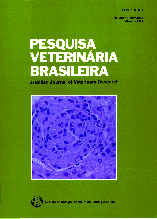 |
|
|
|
Year 1999 - Volume 19, Number 2
|

|
Mineral deficiencies and imbalances in cattle and sheep - a review of Brazilian studies made between 1987 and 1998, 19(2):47-62
|
ABSTRACT.- Tokarnia C.H., Döbereiner J., Moraes S.S. & Peixoto P.V. 1999. [Mineral deficiencies and imbalances in cattle and sheep - a review of Brazilian studies made between 1987 and 1998.] Deficiências e desequilíbrios minerais em bovinos e ovinos - revisão dos estudos realizados no Brasil de 1987 a 1998. Pesquisa Veterinária Brasileira 19(2):47-62. Projeto Sanidade Animal Embrapa/UFRRJ, Seropédica, RJ 23851-970, Brazil.
This review follows on from two previous ones on the subject covering the periods from 1943 to 1976 and 1976 to 1987. They are ali based on the chemical analyses of liver or other animal tissues or fluids and/or experimentation, complemented or not by analyses of pasture and soil samples. They do not include studies based only on chemical analyses of plant and soil samples. Regarding macroelements, noteworthy are the studies on phosphorus deficiency, the most important mineral deficiency shown previusly. Copper and cobalt deficiencies were the most frequent microelement deficiencies. There were several reports on copper poisoning in sheep. Subclinical deficiency of zinc was frequentlyverified. Subclinical manganese deficiency was rarely recognized and to the contrary, elevated values of this element occasionaly were found. There was little data on selenium, so its importance in Brazil remains unclear; nutritional miopathy was diagnosed for the first time in calves, but only once. Low iron values were found in the liver samples of cattle affected by enzootic hematuria. This is easily explained by the continuous loss of blood leading to severe anemia. High iron values were found in the liver samples from some areas; sometimes associated with low copper values. Among the investigations made during the last decade, special mention should be made of two diseases in which the etiology has not yet been established. These are "ronca" (snoring disease) and "doença do peito inchado" (brisket disease), both of which have a chronic course in adult cattle. In "ronca", liver copper is very low and iron particularly high. Presumably the Iatter is caused by poor utilization dueto the copper deficiency. In "doença do peito inchado", the liver values for manganese and cobalt were low and those for iron very high. In this case, the high iron probably comes from the severe liver congestion caused by the chronic cardiac insufficiency seen in this disease. Mention also should be made of "morte súbita". (sudden death) in cattle in the State of Rio Grande do Sul. In this case, liver copper levels were extremely low and no poisonous plant could be blamed. Congenital hypomyelinogenesis in calves was diagnosed in the sarne area. The mineral deficiencies diagnosed during the period of this review are shown on a map, together with the respective bibliographic references. |
| |
|
|
| |
|
 |